Genetic Structure of The Dominant Tropical Seagrasses Cymodocea rotundata and Enhalus acoroides in Southern Philippines for Conservation Management
Abstract
Dan Moywela Arriesgado, Elgen Moywela Arriesgado, Hiroyuki Kurokochi, Rustan Cornelio Eballe, RubyCastrence Gonzales, Chunlan Lian
Large�?�scale genetic population study of the two dominant tropical species of seagrass is conducted in Mindanao, southern Philippines. The goal of the study was to understand population genetic status of the dominant tropical seagrass species, Cymodocea rotundata and Enhalus acoroides for appropriate management. Population genetics structure for the 15 sites was performed by using polymorphic microsatellite markers. The results showed that the clonal richness was high in E. acoroides than C. rotundata. The largest genet found in the study was at Rizal, northern Mindanao wherein throughout the sampling area (i.e. 300 x 40 m) only one genet was identified for C. rotundata. The mean FIS (coefficient of local inbreeding) values was positive (heterozygous deficit) with some sites deviated from Hardy-Weinberg Equilibrium. Isolation by distance (IBD) was detected in C. rotundata (P<0.05) but not in E. acoroides (P=0.253), with the Mindanao ocean currents influenced genetic connectivity and structure. Genetic differentiation did not show any relationship between the geographical location and distance exhibiting high FST values for E. acoroides (0.183) and C. rotundata (0.205). The floating, buoyant fruits of E. acoroides may play a role in their long-distance dispersal; however, such dispersal is not frequent. Almost all of the seeds and fruits of C. rotundata are derived from self-recruitment in the natal meadow. This study suggests that C. rotundata and E. acoroides populations possess a weak genetic connectivity, and that the persistence of the meadow is threatened due to the low genetic diversity and high degree of population isolation.



